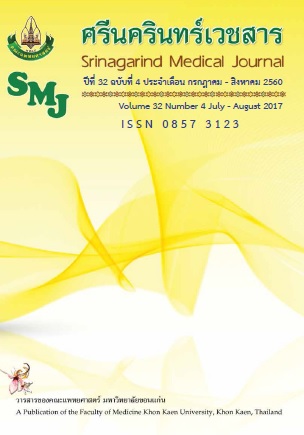Effectiveness of Basic Life Support and Automated External Defibrillator Short-course Training in Undergraduate Students
Keywords:
basic life support, automated external defibrillator, undergraduate students, การช่วยชีวิตขั้นพื้นฐาน, เครื่องช็อกไฟฟ้าหัวใจอัตโนมัติ, ปริญญาตรีAbstract
Background and Objectives: Basic life support (BLS)and automated external defibrillator (AED) usage is one of the first aid procedures which general population can legally perform. Training these procedures for general population will increase survival rate of cardiac arrest patients. Especially training in undergraduate students who are promising population of the country. The objective of the study was to determine effectiveness of short course training basic life support and automated external defibrillator usage, in the total course of 3 hours.
Methods: This was a quasi-experimental non-randomized study in the setting of undergraduate students of Khon Kaen University who registered in elective subject “Medical emergency management in daily life” of faculty of Medicine, Khon Kaen University in the first semester of 2016.
Results: There were 147 participants in basic life support and automated external defibrillator training. Pre-test and post-test median scores were 10 and 15, respectively, which was statistically significant(95%CI5,6; p<0.001). Prior to training, 12 persons (8.1%) passed the written exam and increased to 116 persons (78.9%) after training.In hand-on section, there were 145 persons passed the exam (98.63%) after training. Total number of participants who passed both written and hand-on exams were 114 persons (77.55%).
Conclusion:Short course basic life support and automated external defibrillator usage training were effective for undergraduate students. Since after training, post-test scores were significantly increased and there were participants who passed written and hand-on examination in significant numbers.
ประสิทธิภาพของการอบรมระยะสั้นเรื่องการช่วยชีวิตขั้นพื้นฐานและการใช้เครื่องช็อกไฟฟ้าหัวใจอัตโนมัติในนักศึกษาระดับปริญญาตรี
พัชรียา ศรีสุข, กรกฏ อภิรัตน์วรากุล, กมลวรรณ เอี้ยงฮง, วัชระ รัตนสีหา, แพรว โคตรุฉิน, มธุรส บูรณศักดา
ภาควิชาเวชศาสตร์ฉุกเฉินคณะแพทยศาสตร์ มหาวิทยาลัยขอนแก่น
หลักการและวัตถุประสงค์: การช่วยชีวิตขั้นพื้นฐานและการใช้เครื่องช็อกไฟฟ้าหัวใจอัตโนมัติเป็นการปฐมพยาบาลเบื้องต้นที่ประชาชนสามารถทำได้ตามกฎหมาย การให้ความรู้เรื่องการกู้ชีพแก่ประชาชนจะเพิ่มประสิทธิภาพและโอกาสรอดชีวิตในผู้ป่วยหัวใจหยุดเต้นได้ โดยเฉพาะอย่างยิ่งการฝึกอบรมนักศึกษามหาวิทยาลัยซึ่งเป็นกำลังสำคัญของประเทศ การศึกษานี้จึงมีวัตถุประสงค์เพื่อศึกษาประสิทธิภาพของการอบรมระยะสั้นเรื่องการช่วยชีวิตขั้นพื้นฐานและการใช้เครื่องช็อกไฟฟ้าหัวใจอัตโนมัติภายหลังการอบรมโดยใช้การสอนภาคทฤษฎีและฝึกปฏิบัติกับหุ่นรวมระยะเวลา 3 ชั่วโมง
วิธีการศึกษา: เป็นการศึกษากึ่งทดลองซึ่งศึกษาในนักศึกษาระดับปริญญาตรีทุกคณะที่ลงทะเบียนเรียนวิชาการจัดการภาวะฉุกเฉินทางการแพทย์ในชีวิตประจำวัน ของคณะแพทยศาสตร์ มหาวิทยาลัยขอนแก่น ในภาคการศึกษาที่ 1 ปีการศึกษา 2559
ผลการศึกษา: จำนวนผู้เข้าร่วมวิจัยทั้งหมด 147 ราย มัธยฐานคะแนนภาคทฤษฏีก่อนและหลังการอบรมเท่ากับ 10 และ15 คะแนน ตามลำดับพบว่าต่างกันอย่างมีนัยสำคัญทางสถิติ (95%CI 5,6; p<0.001)มีผู้สอบผ่านเกณฑ์ในภาคทฤษฎีก่อนเรียนจำนวน 12 ราย (ร้อยละ 8.1) หลังการอบรมมีผู้สอบผ่าน 116 ราย (ร้อยละ 78.9) ในภาคปฏิบัติหลังการอบรมมีผู้สอบผ่านจำนวน 145 ราย (ร้อยละ98.63)โดยรวมมีผู้สอบผ่านทั้งภาคทฤษฏีและปฏิบัติจำนวน 114 ราย (ร้อยละ 77.55) (95%CI 69.9, 84.0)
สรุป: การอบรมให้ความรู้ระยะสั้นด้านการช่วยชีวิตขั้นพื้นฐานและการใช้เครื่องช็อกไฟฟ้าหัวใจอัตโนมัติแก่นักศึกษาปริญญาตรีมีประสิทธิภาพ โดยภายหลังการอบรมคะแนนสอบภาคทฤษฏีเพิ่มขึ้นอย่างมีนัยสำคัญทางสถิติและภายหลังการอบรมสามารถเพิ่มจำนวนผู้สอบผ่านภาคทฤษฎีและภาคปฏิบัติได้อย่างมีนัยสำคัญทางสถิติ




